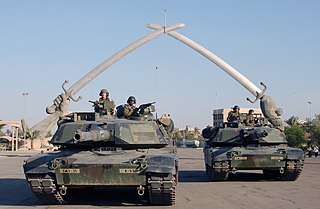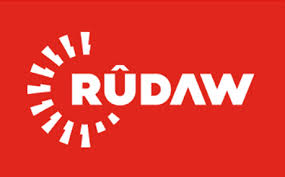
The following is a timeline of major events during the Iraq War, following the 2003 invasion of Iraq.

Jalal Talabani was an Iraqi politician who served as the sixth president of Iraq from 2005 to 2014, as well as the president of the Governing Council of Iraq. He was ethnically Kurdish.

The Badr Organization, previously known as the Badr Brigades or Badr Corps, is an Iraqi Shia Islamist and Khomeinist political party and paramilitary organization headed by Hadi al-Amiri. The Badr Brigade, formed in 1982 and led by Iranian officers, served as the military arm of the Supreme Council for Islamic Revolution in Iraq (SCIRI), a Shia Islamic party based in Iran. The Badr Brigade was created by Iranian intelligence and Shia cleric Mohammad Baqir al-Hakim with the aim of fighting the Ba'athist regime of Saddam Hussein during the Iran–Iraq War. Since the 2003 US-led invasion of Iraq most of the Badr Brigades' fighters have entered the new Iraqi army and police force. Politically, Badr Brigade and SCIRI were considered to be one party since 2003, but have now unofficially separated with the Badr Organization now an official Iraqi political party. Badr Brigade forces, and their Iranian commanders, have come to prominence in 2014 fighting the Islamic State of Iraq and the Levant (ISIL) in Iraq. It is a part of the Popular Mobilization Forces.

The Imam Husayn Shrine is the mosque and burial site of Husayn ibn Ali, the third Imam of Shia Islam, in the city of Karbala, Iraq. It stands on the site of the Mausoleum of Husayn, who was a grandson of Muhammad, near the place where he embraced martyrdom during the Battle of Karbala in 680 CE The tomb of Husayn is one of the holiest sites in Shia Islam, outside of Mecca and Medina, and many make pilgrimages to the site. Every year, millions of pilgrims visit the city to observe Ashura, which marks the commemoration of Husayn's death for all Muslims.

The history of Islam in Iraq goes back almost 1,400 years to the lifetime of Muhammad. Iraq's 98% majority Muslims follow two distinct traditions: Shia Islam (55-60%) and Sunni Islam (35-40%).
Religion in Iraq dates back to Ancient Mesopotamia, particularly Sumer, Akkad, Assyria and Babylonia between circa 3500 BC and 400 AD, after which they largely gave way to Syriac Christianity and later to Islam.
The Karbala provincial headquarters raid was a special operation carried out on January 20, 2007, by the Asa'ib Ahl al-Haq against the U.S. contingent of the Joint Security Station, located within the Iraqi Police headquarters. The assault, which left five U.S. soldiers dead and three wounded, has been called the "boldest and most sophisticated attack in four years of warfare" and is furthermore notable for being one of the few instances when any sort of militants or insurgents have actually managed to capture U.S. soldiers since the Vietnam War.

The following outline is provided as an overview of and topical guide to Iraq:
The mass media in Iraq includes print, radio, television, and online services. Iraq became the first Arab country to broadcast from a TV station, in 1954. As of 2020, more than 100 radio stations and 150 television stations were broadcasting to Iraq in Arabic, English, Kurdish, Turkmen, and Neo-Aramaic.

The Al-Abbas Shrine is the mausoleum of Abbas ibn Ali and a mosque, located near the Imam Husayn Mosque in Karbala, Iraq. Abbas was son of Ali ibn Abi Talib and the half-brother of Imam Hasan and Imam Husayn. He was Husayn's flag-bearer in the Battle of Karbala and chief of his caravans. The shrine is revered by the Shia Muslims who visit it every year, especially in the month of Muharram.
Events in the year 2011 in Iraq.

The 2011 Iraqi protests came in the wake of the Tunisian revolution and 2011 Egyptian revolution. They resulted in at least 45 deaths, including at least 29 on 25 February 2011, the "Day of Rage".

Rudaw Media Network, is a major media broadcaster in the Kurdistan Region, Iraq.

Tourism in Iraq refers to tourism in the Western Asian country of Iraq. Iraq was one of the main destinations for many years, however this changed dramatically due to conflicts. Tourism in Iraq has faced many challenges, however, in recent years there have been improvements. The capital city Baghdad is the second largest city in the Arab world and the 4th largest in the Middle East. Iraq has several World Heritage Sites, dating back to ancient Mesopotamia, most notably Babylon Iraq. Iraq is considered to be a potential location for ecotourism. Erbil was chosen as "Arab Tourism Capital" in 2014 by the Arab Tourism Committee.

A series of demonstrations, marches, sit-ins and civil disobedience took place in Iraq from 2019 until 2021. It started on 1 October 2019, a date which was set by civil activists on social media, spreading mainly over the central and southern provinces of Iraq, to protest corruption, high unemployment, political sectarianism, inefficient public services and foreign interventionism. Protests spread quickly, coordinated over social media, to other provinces in Iraq. As the intensity of the demonstrations peaked in late October, protesters’ anger focused not only on the desire for a complete overhaul of the Iraqi government but also on driving out Iranian influence, including Iranian-aligned Shia militias. The government, with the help of Iranian-backed militias responded brutally, using live bullets, marksmen, hot water, hot pepper gas and tear gas against protesters, leading to many deaths and injuries.
The COVID-19 pandemic in Iraq was a part of the worldwide pandemic of coronavirus disease 2019 caused by severe acute respiratory syndrome coronavirus 2. During the pandemic, Iraq reported its first confirmed cases of SARS-CoV-2 infections on 22 February 2020 in Najaf. By April, the number of confirmed cases had exceeded the hundred mark in Baghdad, Basra, Sulaymaniyah, Erbil and Najaf.
Events in the year 2021 in Iraq.

Between the parliamentary election in October 2021 and October 2022, there was a political crisis in Iraq, with members of the Council of Representatives of Iraq being unable to form a stable coalition government, or elect a new President. Basic government services such as the civil service and military continued functioning, but the national political system was in deadlock including in respect of almost all major spending and taxation issues. On 27 October 2022, the government of Prime Minister Mohammed Shia' Al Sudani was approved by the Council of Representatives.











